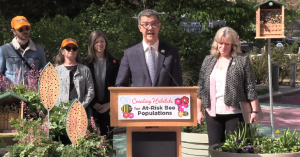What to know about the G train summer shutdown
By Ana Borruto

The 11.4-mile long Brooklyn-Queens Crosstown G train subway service will be partially shut down this summer for track reconstruction and modern signal installation.
Starting Friday, June 28, the G train will undergo the first phase of an extensive multi-week, 24/7 project to replace its 1930s-era legacy signal system with Communications-based train control (CBTC) — a wireless connectivity system that keeps trains in constant contact, and in turn, more reliable.
Assemblymember Emily Gallagher, Senator Kristen Gonzalez and Councilmember Lincoln Restler hosted a town hall on Thursday, May 30 at John Ericsson Middle School in Greenpoint, Brooklyn, where representatives of the Metropolitan Transit Authority and New York City Department of Transportation explained how the shutdown will catapult the G train “into the 21st century.”
The forum allowed for regular G train commuters to ask questions and express their concerns about the shutdown, which was described as a “huge inconvenience” to the Greenpoint community and beyond.
“When we got this news a few months ago, we pushed and prodded the MTA to consider if there are ways to do just overnight work, are there ways to limit this so we don’t have to endure a six-week full shutdown of this train line,” said Restler. “We haven’t been able to identify an alternative path forward, they are insistent that this is the necessary way to go.”
Sean Fitzpatrick of the MTA explained exactly why the service outages are needed on the G train, the main reason being the age of the subway line.
The G train has some of the oldest signals left in the New York City train system, which has caused “below average” performance times, according to Fitzpatrick. The current system is fixed-blocked signaling, which means the trains are divided and registered into fixed blocks with buffers up to 1,000 feet long installed between them.
“It’s a marvel of early 20th century engineering,” Fitzpatrick said.
However, the drawbacks of this current system include not being able to pinpoint the exact location of a train, so trains run farther apart to create a safety buffer — creating service delays.
The infrastructure for fixed-block signaling is also expensive to install and maintain.
CBTC signaling allows trains to transpond to one another: in simple terms, the train’s position on the track is easily located because the section of track around each train moves with the train, rather than being on pre-defined, fixed blocks.
“We are able to run them more closely together, more quickly, while maintaining safety,” Fitzpatrick said. “We also have a better view of the entire system so we’re able to respond better when there are incidents — it’s the single biggest investment that we can make to improve the reliability of a train.”
This transition from a fixed-block to CBTC system for the G train requires the installation of new signaling equipment, replacement of 30 miles of track and more than a dozen switches and the integration and testing of the new system.
Fitzpatrick said replacing the 1930s-period switches and tracks is particularly challenging, especially in the underground tunnels. To create a safe, workable environment for the project, the MTA said it has no choice but to shut down the G train line temporarily.
With ridership lower in the summertime and school not in session, Fitzpatrick said it is the ideal time for the outage to take place.
He added the MTA is promising to be finished with the reconstruction by Sept. 2.
During the outage, shuttle buses will be available at impacted stations every one to four minutes during the weekdays and every five to 10 minutes on the weeknights.
Shuttle buses can be expected to arrive at stations on weekend mornings and evenings every three to five minutes; every five to 10 minutes on late nights.
Several tools will be implemented to keep traffic moving and areas clear for the shuttle buses, such as turn restrictions, daylighting, monitoring and automated camera enforcement.
Here is the timeline of the shutdown and list of alternative shuttle bus transportation options:
Phase 1: Friday, June 28 to Friday, July 5
- G trains won’t run between Court Square and Nassau Avenue
- Free B94 shuttle buses will run between Court Square and Nassau Avenue and make all stops.
Phase 2: Friday, July 5 to Friday, August 12
- G trains won’t run between Court Square and Bedford-Nostrand Avenues.
- Free B98 shuttle buses will run between Court Square and Bedford-Nostrand Avenues and make all stops.
Phase 3: Friday, August 12 to Tuesday, September 3
- G trains won’t run between Bedford-Nostrand Avenues and Church Avenue.
- Free B93 shuttle buses will run between Bedford-Nostrand Avenues and Jay Street-MetroTech, making all stops between Bedford-Nostrand Avenues and Hoyt-Schermerhorn.
The overall long term work of the G train will continue into 2027. With this specific line becoming the go-to transportation option in some of the fastest growing communities in the state, elected officials are urging Governor Kathy Hochul and the MTA to further invest in the G train’s future.
This includes extending the G train back to Forest Hills, Queens. According to Gallagher’s public campaign in favor of a full G train upgrade, the petition mentioned how up until 2010, the G train served parts of Astoria, Woodside, Jackson Heights, Elmhurst, Rego Park and Forest Hills.
“The G is our lifeline in this community,” said Gallagher. “It’s going to be a very long summer.”
To find out more information about the G train shutdown this summer, visit tinyurl.com/ymv5b99c.





















